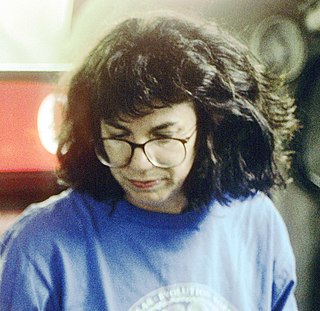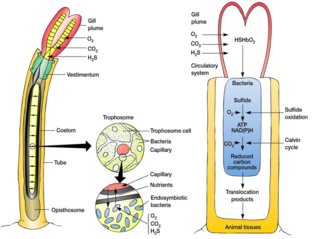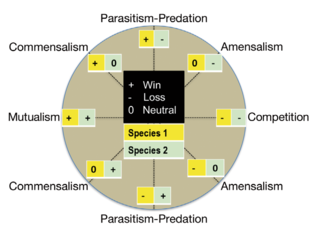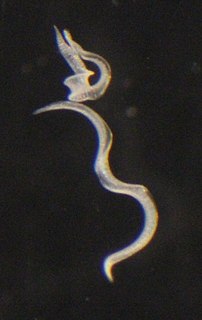Related Research Articles

An endosymbiont or endobiont is any organism that lives within the body or cells of another organism most often, though not always, in a mutualistic relationship. (The term endosymbiosis is from the Greek: ἔνδον endon "within", σύν syn "together" and βίωσις biosis "living".) Examples are nitrogen-fixing bacteria, which live in the root nodules of legumes; single-cell algae inside reef-building corals, and bacterial endosymbionts that provide essential nutrients to about 10–15% of insects.

Riftia pachyptila, commonly known as the giant tube worm, is a marine invertebrate in the phylum Annelida related to tube worms commonly found in the intertidal and pelagic zones. R. pachyptila lives on the floor of the Pacific Ocean near hydrothermal vents, and can tolerate extremely high hydrogen sulfide levels. These worms can reach a length of 3 m, and their tubular bodies have a diameter of 4 cm (1.6 in). Ambient temperature in their natural environment ranges from 2 to 30°C.
Symbiotic bacteria are bacteria living in symbiosis with another organism or each other. For example, Zoamastogopera, found in the stomach of termites, enable them to digest cellulose.
The Class Gammaproteobacteria belongs to the Proteobacteria phylum and contains about 250 genera, which makes it the most genera-rich taxa of the Prokaryotes. Several medically, ecologically, and scientifically important groups of bacteria belong to this class. It is composed by all Gram-negative microbes and is the most phylogenetically and physiologically diverse class of Proteobacteria. The word Gammaproteobacteria comes from three Greek words: the Greek letter "gamma" (γ) meaning "changeable", the word proteakos (πρωτεϊκός) "little stick", and βακτήριον, that means "bacterium", so it means "changeable little stick bacterium". The name refers to Proteus, the Greek sea god who could change his shape. These microorganisms can live in several terrestrial and marine environments, in which they play various important roles, including extreme environments like the hydrothermal vents. They generally have different shapes, like rods, curved rods, cocci, spirilla, and filaments and include free living bacteria, biofilm formers, commensals and symbionts, some also have the distinctive trait of being bioluminescent. Metabolisms found in the different genera are very different; there are both aerobic and anaerobic species, chemolithoautotrophics, chemoorganotrophics, photoautotrophs and heterotrophs.

Lucinidae is a family of saltwater clams, marine bivalve molluscs.

Colleen Cavanaugh is an American academic microbiologist best known for her studies of hydrothermal vent ecosystems. As of 2016, she is the Edward C. Jeffrey Professor of Biology in the Department of Organismic and Evolutionary Biology at Harvard University and is affiliated with the Rowland Institute. Cavanaugh was the first to propose that the deep-sea giant tube worm, Riftia pachyptila, obtains its food from bacteria living within its cells, an insight which she had as a graduate student at Harvard. Significantly, she made the connection that these chemoautotrophic bacteria were able to play this role through their use of chemosynthesis, the biological oxidation of inorganic compounds to synthesize organic matter from very simple carbon-containing molecules, thus allowing organisms such as the bacteria to exist in deep ocean without sunlight.

A trophosome is a highly vascularised organ found in some animals that houses symbiotic bacteria that provide food for their host. Trophosomes are located in the coelomic cavity in the vestimentiferan tube worms and in symbiotic flatworms of the genus Paracatenula.

Solemya velum, the Atlantic awning clam, is a species of marine bivalve mollusc in the family Solemyidae, the awning clams. This species is found along the eastern coast of North America, from Nova Scotia to Florida.
Laxus is a genus of nematode worms from the subfamily Stilbonematinae of the family Desmodoridae. Like other members of this subfamily, they are covered by a layer of symbiotic sulfur-oxidizing bacteria, which in Laxus are coccoid in shape. They are distinguished from other stilbonematine genera by the finely-annulated somatic cuticle, thickened cephalic cuticle, small and coiled amphidial fovea, and lack of male structures. There are at least five species in the genus.

Olavius algarvensis is a species of gutless oligochaete worm in the family Tubificidae which depends on symbiotic bacteria for its nutrition.

Solemya is a genus of saltwater clams, marine bivalve mollusks in the family Solemyidae, the awning clams. Solemya is the type genus of the family Solemyidae.

Paracatenula is a genus of millimeter sized free-living marine gutless catenulid flatworms.

Microbial symbiosis in marine animals was not discovered until 1981. In the time following, symbiotic relationships between marine invertebrates and chemoautotrophic bacteria have been found in a variety of ecosystems, ranging from shallow coastal waters to deep-sea hydrothermal vents. Symbiosis is a way for marine organisms to find creative ways to survive in a very dynamic environment. They are different in relation to how dependent the organisms are on each other or how they are associated. It is also considered a selective force behind evolution in some scientific aspects. The symbiotic relationships of organisms has the ability to change behavior, morphology and metabolic pathways. With increased recognition and research, new terminology also arises, such as holobiont, which the relationship between a host and its symbionts as one grouping. Many scientists will look at the hologenome, which is the combined genetic information of the host and its symbionts. These terms are more commonly used to describe microbial symbionts.
Olavius finitimus is a species of clitellate oligochaete worm, first found in Belize, on the Caribbean side of Central America.
Zoothamnium niveum is a species of ciliate protozoan which forms feather-shaped colonies in marine coastal environments. The ciliates form a symbiosis with sulfur-oxidizing chemosynthetic bacteria of the species "Candidatus Thiobios zoothamnicoli", which live on the surface of the colonies and give them their unusual white color.

Kentrophoros is a genus of ciliates in the class Karyorelictea. Ciliates in this genus lack a distinct oral apparatus and depend primarily on symbiotic bacteria for their nutrition.
Astomonema is a genus of nematode worms in the family Siphonolaimidae. They lack a mouth or conventional digestive tract, but contain symbiotic sulfur-oxidizing bacteria that serve as their primary food source. They live in the marine interstitial habitat.
Nicole Dubilier is a marine microbiologist and director of the Symbiosis Department at the Max Planck Institute for Marine Microbiology since 2013 and a Professor of Microbial Symbioses at the University of Bremen. She is a pioneer in ecological and evolutionary symbiotic relationships between sea animals and their microbial partners inhabiting environments that harbour low nutrient concentrations. She was responsible for the discovery of a new form of symbiosis between two kinds of bacteria and the marine oligochaete Olavius algarvensis.
Olavius is a genus of clitellate oligochaete worm.
Phallodrilinae is a subfamily of clitellate oligochaete worm.
References
- 1 2 Tchesunov, Alexei V. (February 2013). "Marine free-living nematodes of the subfamily Stilbonematinae (Nematoda, Desmodoridae): taxonomic review with descriptions of a few species from the Nha Trang Bay, Central Vietnam". Meiofauna Marina. 20: 71–94.
- ↑ Ott, Jörg; Bright, Monika; Bulgheresi, Silvia (2004). "Symbioses between marine nematodes and sulfur-oxidizing chemoautotrophic bacteria". Symbiosis. 36: 103–126.
- 1 2 Polz, Martin F.; Felbeck, Horst; Novak, Rudolf; Nebelsick, Monika; Ott, Jörg A. (1992-11-01). "Chemoautotrophic, sulfur-oxidizing symbiotic bacteria on marine nematodes: Morphological and biochemical characterization". Microbial Ecology. 24 (3): 313–329. doi:10.1007/bf00167789. ISSN 0095-3628. PMID 24193210.
- ↑ Zimmermann, Judith; Wentrup, Cecilia; Sadowski, Miriam; Blazejak, Anna; Gruber-Vodicka, Harald R.; Kleiner, Manuel; Ott, Jörg A.; Cronholm, Bodil; De Wit, Pierre (2016-07-01). "Closely coupled evolutionary history of ecto- and endosymbionts from two distantly related animal phyla". Molecular Ecology. 25 (13): 3203–3223. doi: 10.1111/mec.13554 . ISSN 1365-294X. PMID 26826340.
- ↑ Ott, J. A.; Novak, R.; Schiemer, F.; .Hentschel, U; Nebelsick, M.; Polz, M. (1991-09-01). "Tackling the Sulfide Gradient: A Novel Strategy Involving Marine Nematodes and Chemoautotrophic Ectosymbionts". Marine Ecology. 12 (3): 261–279. doi:10.1111/j.1439-0485.1991.tb00258.x. ISSN 1439-0485.
- ↑ Bulgheresi, Silvia; Gruber-Vodicka, Harald R.; Heindl, Niels R.; Dirks, Ulrich; Kostadinova, Maria; Breiteneder, Heimo; Ott, Joerg A. (June 2011). "Sequence variability of the pattern recognition receptor Mermaid mediates specificity of marine nematode symbioses". The ISME Journal. 5 (6): 986–998. doi:10.1038/ismej.2010.198. ISSN 1751-7362. PMC 3131856 . PMID 21228893.